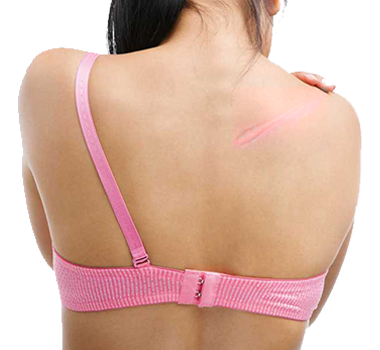Scar removal surgery abroad
This is a skin reconstructive cosmetic surgery, for unsightly and pathological scars.
This scars’ surgical revision aims to successfully hide most of the old scar and make it more discreet.
This, scars correction procedure, is feasible on most parts of the body.
Depending on the nature of the scar (retractile, ulcerated, depressed, keloid ...), various surgical and medical techniques can be practiced to correct the external appearance (skin grafting, skin expansion, local plasty, excision).
In order to be treated, surgically speaking, a scar must be stabilized and in the final stage of its natural evolution. An operable scar must be between 6 months and 2 years of age.
It is not realistic to aim for the skin to be back to its natural state before the scar.Surgery does not, remove, erase or make a scar disappear. We talk about "reverse," "correct" or "revise" the scar.
So a scar never disappears completely, even with the help of surgery or other non-surgical methods: creams, tattoos, LED, laser, peeling, etc.
However, the appearance of scars can be "touched up" and enhanced by various surgical or soft terms. The aim of scars’ surgical correction is mitigating and not deleting them. They will then be blurred, to be more aesthetic and less unpleasant.
If the skin undergoes a major assault ( surgical incision , burns, injury ...), it will inevitably results in one or more scars.

Although the reconstructive surgery techniques used for sewing the skin changes, it is important to know that scars never completely disappears and a trace, however small, can persist.
The healing process is manifested by scarring. The scar tissue that results is different from the replaced tissue and is generally of lower quality.
Like dermatologic surgery, healing involves three major steps:
- The first step comes days after the procedure; the scar is usually nice and fine.
- In the second step, that is to say during the 1-2 months after the operation, it turns red, becomes hard and swollen. It also causes frequent itching. This stage lasts 3 to 6 months.
- After this period, the scar reaches its third and final stage. She begins to thin and turn white and softens more. On the other hand, itching gradually cease. After this relatively long and unpredictable processing, resulting scar is permanent and indelible, it is white, flexible and insensitive.
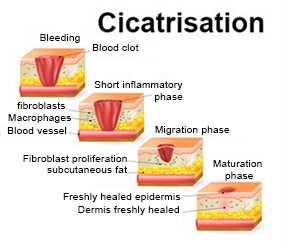
In order to get a more discreet scar, some simple and healthy actions are recommended during convalescence:
- Avoid exposing the scar to the sun regardless of the location on the body. For that do not hesitate to eventually wear suitable clothing, a hat or use sunscreen ...
- It is important to moisturize the affected skin with creams made for this purpose: the healing creams in this case. Take the opportunity to massage the area every day.
- In certain circumstances, the surgeon prescribes the use of the silicone plate or gel. This helps to relieve redness and reduce the bloated appearance.
Neither surgery nor other methods (creams, PRP, peeling, laser, mésolthérapie ...) completely make a scar disappear.
A scar Surgical revision, as a type of correction, recovery or review, aims to replace a vicious scar with a new, hopefully, less visible scar, less unattractive and more discreet.
It is customary in most cases, to treat only stable scars, that is to say, once they have reached the end of their third stage of natural evolution (six months to two years) .
After the assessment of the plastic surgeon, the latter may deem possible to make a correction or scar revision in the following cases:
- Retractable Scars : these are scars, representing induration and "callous" that does not allow you to stretch the skin. They are very unsightly and can sometimes restrict certain movements.
- Ulcerated scars :they are so fragile, they suffer frequent damage in the form of "abrasions". These abrasions are superficial, and then become permanent and increasingly widened. This can worsen the condition of the scar.
- Hypertrophic scars or keloid:they are inflammatory and sensitive. They are red, widened and in particular inflated, in other words, "raised". They are very difficult to treat and more prone to recurrences.
- Unsightly Scars :widespread, pigmented atypical shifted, dug, adherent, tough, ...
Note that sometimes, regardless of the surgical techniques, normal scars widen, this expansion is due to a disorder of the patient’s own healing.
Usually, it should initiate a correction on mature and stabilized scars, that is to say 18 to 24 months following their occurrence.
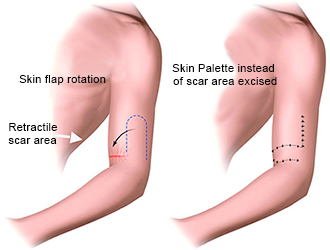
The simplest recovery interventions, is an excision of the scar and wound closure based on the natural skin lines . this will result in a more discreet and aesthetic scar.
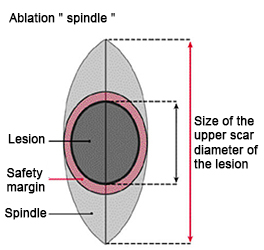
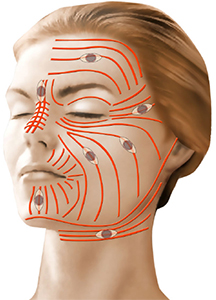
Several techniques can be employed in the case of more severe scarring :
- Proceed through several stages , and circumcise every time so that the skin relaxes between operations .
- Skin graft
- Local Plastic Surgery by local flap
- Skin Expansion using inflatable balloons , the skin around the scar relaxes. The excess skin is then used to cover the treatment area .

It should be noted that it is impossible to remove a scar completely. But over time, a scar becomes more discreet but not completely invisible.
- The patient should stop smoking at least one month before and one month after the resumption of the scar.
- Taking medications containing aspirin should be avoided during the 10 days preceding the correction operation of the scar.
In the majority of cases, local anesthesia is sufficient for the skin surgery. This one, not requiring hospitalization, can be performed as an outpatient clinic or even in the office.
A scar can be improved in several ways:
- A Scar Surgical excision, either totally or partially. Then it gets replaced by finer sutures or a skin graft or flap.
- Changing the direction of the scar with the lower tension lines, allowes an optimal orientation of the scar.
- PRP Injections (Platelet Rich Plasma) or mesotherapy.
- Lipofilling or hyaluronic acid fillers for depressed scars.
- Medical Lasers (dermatological treatment).
- Prescription corticosteroid injections or topical.
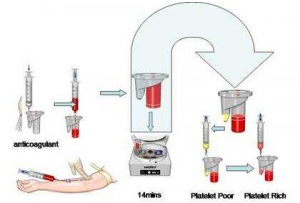

The practice of scars removal surgery is usually done when the scars have had time to heal completely (mature scars) and can hang up to two years after the injury that caused the original scar.
After surgery, it is normal if the scar may seem uncomfortable, giving rise to a feeling of tension.
It does not matter if the blood seeps or lymph is observed. Edema (swelling) or small bruises (blue) will also appear within 48 hours of the procedure.
During the healing phase, itching is common. The nonabsorbable son will be removed between the 5th and 15th day.
Precautions :- Avoid exposing the scar to the sun during the healing phase.
- Use sunscreen with a high SPF if risk of exposure.
- Avoid pulling or traumatizing the scar.
The operative risks are rare, they can result in:
- Bruising
- An infection
- Eschar (skin necrosis)
- A healing abnormalities (hypertrophy, keloid)
- Numbness or mostly transient sensory disorders
You let must several months pass (sometimes up to one to two years) to reach the final appearance desired.
As a random and uncertain phenomenon, scars healing can not provide a guaranteed quality result. A perfect technical mastery of the plastic surgeon, who must be qualified and specifically trained for this type of intervention, helps to attract the odds on his side.
However, the unpredictability remains. It is basically recommended to regularly monitor the development and appearance of a scar resulting from surgical correction of abnormal scar. This is the only way that ensures the identification to potential problems with healing time and to take appropriate steps to implement appropriate treatment.
The end result will never reach perfection, that is, the scar will not be invisible but the surgery will help make it more aesthetic and discreet.
Scar removal surgery in Tunisia
- Procedure :Aesthetic and Reconstructive Surgery of vicious scars, that aims to blur, at best, an old scar and make it more discreet, regardless of location on the body .
- Anesthesia: Local
- Operating Duration :½ - 1 hour
- Duration of hospital stay :the same day
- Recovery : 10 to 12 days
